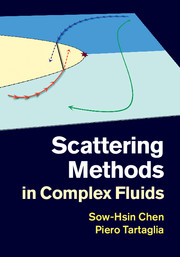Book contents
- Frontmatter
- Contents
- List of illustrations
- Preface
- Part I Scattering and liquids
- Part II Structural arrest
- Part III Water
- 7 Dynamic crossover phenomena in confined water
- 8 Dynamic crossover phenomena in other glass-forming liquids
- 9 Inelastic neutron scattering in water
- 10 Introduction to high-resolution inelastic X-ray scattering spectroscopy
- References
- Index
8 - Dynamic crossover phenomena in other glass-forming liquids
from Part III - Water
Published online by Cambridge University Press: 05 May 2015
- Frontmatter
- Contents
- List of illustrations
- Preface
- Part I Scattering and liquids
- Part II Structural arrest
- Part III Water
- 7 Dynamic crossover phenomena in confined water
- 8 Dynamic crossover phenomena in other glass-forming liquids
- 9 Inelastic neutron scattering in water
- 10 Introduction to high-resolution inelastic X-ray scattering spectroscopy
- References
- Index
Summary
Introduction
There are several theories and models of glassy behaviour. For example, Binder and Kob discussed these in great details in their book (Binder and Kob, 2011), with extensive references. Theories often cited are, for example, Adam–Gibbs theory (Adam and Gibbs, 1965), free-volume theory (Cohen and Turnbull, 1959; Turnbull and Cohen, 1961, 1970), mode-coupling theory (MCT), random firstorder theory (RFOT), etc. While all these theories and models can certainly enhance our understanding of glass-forming systems, none seems to be flawless. Some are too sophisticated and complex, while others are too macro in their approach and make simple assumptions. Thus there is plenty of room for much more in-depth research and experiments. In this chapter, we shall place more emphasis on recent experimental results, which can help us to understand better the complex landscapes and systems of the glass-forming liquids. Whenever possible, we will relate the results to some of the available theories.
In Chapter 7, we have already discussed the dynamic crossover (often called fragile-to-strong dynamic crossover, FSC) phenomenon in supercooled water found by Chen and coworkers (Faraone et al., 2004). Therefore, in this chapter, we are exploring such phenomena in other glass-forming liquids. It has been found that there is a similar dynamic crossover behaviour in other glass-forming liquids, substantiated not only by mode-coupling theory and MD simulations, but also collaborated with many experimental results (Chen et al., 2009b). We shall expand on this in the following.
8.1.1 Experimental results on transport coefficients
The existing data on transport coefficients of common bulk glass-forming liquids exhibit the same FSC phenomena as water does. For example, in Figure 8.1, for the well-known case of o-terphenyl, the Arrhenius plots of the inverse of the self-diffusion constant (top panel) (Mapes et al., 2006) together with the viscosity (middle panel) and followed by the specific heat (lower panel) are shown (Laughlin and Uhlmann, 1972).
- Type
- Chapter
- Information
- Scattering Methods in Complex Fluids , pp. 274 - 285Publisher: Cambridge University PressPrint publication year: 2015



